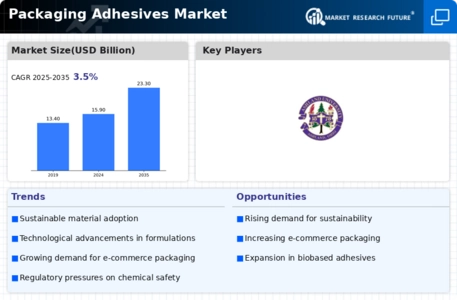Leading market players are investing heavily in research and development in order to expand their product lines, which will help the Packaging Adhesives market, grow even more. Market participants are also undertaking a variety of strategic activities to expand their global footprint, with important market developments including new product launches, contractual agreements, mergers and acquisitions, higher investments, and collaboration with other organizations. To expand and survive in a more competitive and rising market climate, Packaging Adhesives industry must offer cost-effective items.
Manufacturing locally to minimize operational costs is one of the key business tactics used by manufacturers in the global Packaging Adhesives industry to benefit clients and increase the market sector. In recent years, the Packaging Adhesives industry has offered some of the most significant advantages to medicine. Major players in the Packaging Adhesives market, including 3M, Arkema Group (Bostik), AVERY DENNISON CORPORATION, Ashland, Dow, Henkel AG & Co. KGaA, H.B. Fuller Company, Jowat SE, Paramelt RMC B.V., Wacker Chemie AG and others, are attempting to increase market demand by investing in research and development operations.
Manufacturer and distributor of industrial goods and services is 3M Co. The company's product line also includes advanced materials, display materials and systems, stationery and office supplies, home care, home renovation, roofing granules, closure and masking systems, and other items. Additionally, 3M provides a range of services, including medical, dental, consumer health, food safety, and health information systems. Customers from a variety of industries, including automotive, electronics, health care, safety, energy, and consumer, are served by it. Asia Pacific, Europe, the Middle East, Africa, and the Americas are all regions where the corporation has manufacturing and converting operations.
The US city of St. Paul, Minnesota, is home to 3M.
Labeling and packaging supplies are provided by Avery Dennison Corp (Avery Dennison). It creates tags, labels, tickets, and other conversion goods in addition to pressure-sensitive materials. Additionally, Avery Dennison produces and markets fasteners, tickets, tags, RFID inlays and tags, imprinting tools, and related services. The business sells goods under the names of Avery Dennison, Yongle, Fasson, Monarch, Freshmarx, JAC, and Mactac, among other brands. Retail, construction, footwear and apparel, logistics, e-commerce, pharmaceuticals, food and grocery, the automotive industry, and the healthcare sector are just a few of the industries it supports.
The business has operations in Asia Pacific, Europe, South America, and North America. The US state of California is home to Avery Dennison's corporate headquarters.






Leave a Comment